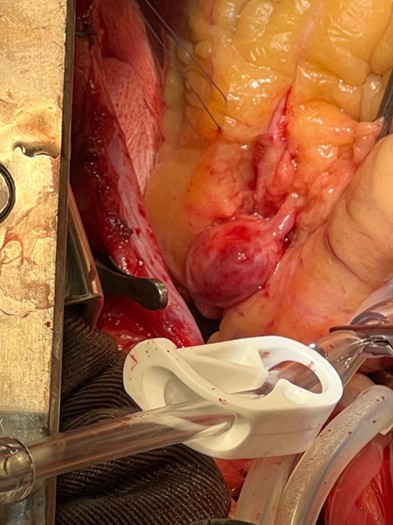Surgical Management of Left Anterior Descending Coronary Artery Aneurysm with Fistula: A Rare Case Report from Suriname
Main Article Content
Abstract
Coronary artery aneurysm (CAA) and coronary artery fistula (CAF) are rare cardiovascular anomalies, and their simultaneous occurrence is exceedingly uncommon. This case highlights the diagnostic, therapeutic, and logistical challenges of managing such anomalies in a low-resource setting. We present a 56-year-old woman with diabetes, hypertension, and hypothyroidism who developed a non-ST-elevation myocardial infarction (NSTEMI) in May 2023, nearly two years after being diagnosed with a proximal left anterior descending (LAD) artery saccular aneurysm (15.5 × 19.2 mm) with two fistulous connections (31.9 mm and 20 mm). Initial conservative management was chosen due to patient stability and operating room limitations during the COVID-19 pandemic. Despite optimal medical therapy, aspirin 80 mg/day, clopidogrel 75 mg/day, simvastatin 40 mg/day, and bisoprolol 5 mg/day, worsening symptoms prompted urgent surgical repair. The aneurysm and fistulas were ligated, and a left internal mammary artery (LIMA) to LAD bypass was performed. Postoperative complications included pulmonary congestion and pneumonia, both of which were successfully treated. The patient remains asymptomatic at two-year follow-up. In anatomically complex coronary artery anomalies, surgical intervention may offer a definitive treatment option. Our case emphasizes the importance of adaptable, case-specific strategies for cardiovascular care in resource-limited environments.
Article Details

This work is licensed under a Creative Commons Attribution 4.0 International License.
Authors retain the copyright of their articles and grant the journal the right of first publication under the Creative Commons Attribution (CC BY) license, which allows others to share and adapt the work with proper attribution.
References
Kawsara A, Núñez Gil IJ, Alqahtani F, Moreland J, Rihal CS, Alkhouli M. Management of coronary artery aneurysms. JACC Cardiovasc Interv. 2018;11(13):1211-23. https://doi.org/10.1016/j.jcin.2018.04.003.
Li D, Wu Q, Sun L, Song Y, Wang W, Pan S, et al. Surgical treatment of giant coronary artery aneurysm. J Card Surg. 2017;32(11):767-71. https://doi.org/10.1111/jocs.13172.
Swaye PS, Fisher LD, Litwin P, Vignola PA, Judkins MP, Kemp HG, et al. Aneurysmal coronary artery disease. Curr Cardiol Rev. 2016;12(2):123-30. https://doi.org/10.2174/1573403x12666160516103604.
Latson LA. Coronary artery fistula: How to manage them. Tex Heart Inst J. 2017;44(2):130-2. https://doi.org/10.14503/THIJ-17-6275.
Syed M, Lesch M. Coronary artery fistula: A review. Arch Cardiovasc Dis. 2020;113(1):47-53. https://doi.org/10.1016/j.acvd.2019.09.002.
Güvenç TS, Tutar HE, Şaşmazel A, Erer D. Left anterior descending coronary artery compressed by a giant coronary fistula aneurysm: A case report. Eur Heart J Case Rep. 2019;3(1):ytz002. https://doi.org/10.1093/ehjcr/ytz002.
Kamiya H, Yasuda T, Nagamine H, Shimura T, Kanazawa T, Uchida T, et al. Systematic review of 1007 patients with coronary artery aneurysm and fistula (2002–2021): Outcomes of surgical versus percutaneous treatment. Ann Thorac Surg. 2022;114(3):982-90. https://doi.org/10.1016/j.athoracsur.2022.03.046.
